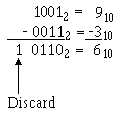1-22
Step 4—Remember to discard any carry beyond the size of the original number. Our original
problem had four digits, so we discard the carry that expanded the difference to five digits.
This carry we disregard is significant to the computer. It indicates that the difference is
positive. Because we have a carry, we can read the difference directly without any further
computations. Let's check our answer:
If we do not have a carry, it indicates the difference is a negative number. In that case, the difference
must be R's complemented to produce the correct answer.
Let's look at an example that will explain this for you.
Subtract 910 from 510 (10012 from 01012):
Step 1—Leave the minuend alone:
01012 remains 01012
Step 2—R's complement the subtrahend:
01112 R's complement of subtrahend
Step 3—Add the R's complement found in step 2 to the minuend of the original problem:
Step 4—We do not have a carry; and this tells us, and any computer, that our difference (answer) is
negative. With no carry, we must R's complement the difference in step 3. We will then
have arrived at the answer (difference) to our original problem. Let's do this R's
complement step and then check our answer:
01002 R's complement of difference in step 3
Remember, we had no carry in step 3. That showed us our answer was going to be negative. Make
sure you indicate the difference is negative. Let's check the answer to our problem:







